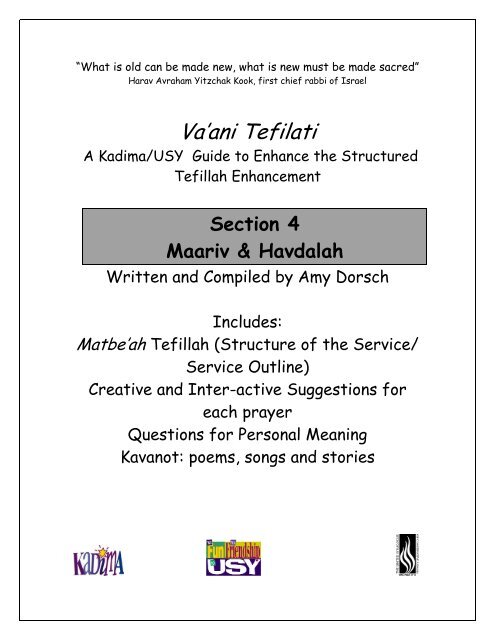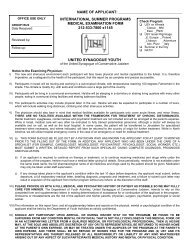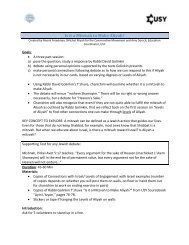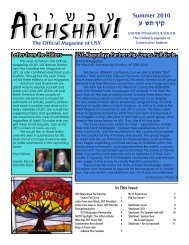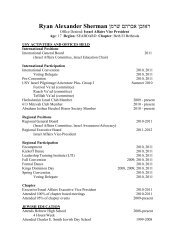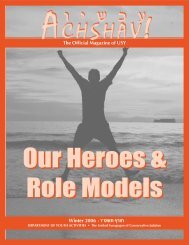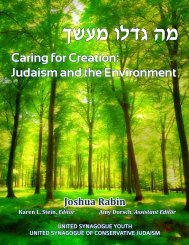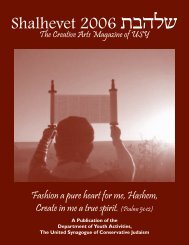Guide to Creative Tefillot- Maariv Havdalah
Guide to Creative Tefillot- Maariv Havdalah
Guide to Creative Tefillot- Maariv Havdalah
Create successful ePaper yourself
Turn your PDF publications into a flip-book with our unique Google optimized e-Paper software.
“What is old can be made new, what is new must be made sacred”<br />
Harav Avraham Yitzchak Kook, first chief rabbi of Israel<br />
Va’ani Tefilati<br />
A Kadima/USY <strong>Guide</strong> <strong>to</strong> Enhance the Structured<br />
Tefillah Enhancement<br />
Section 4<br />
<strong>Maariv</strong> & <strong>Havdalah</strong><br />
Written and Compiled by Amy Dorsch<br />
Includes:<br />
Matbe’ah Tefillah (Structure of the Service/<br />
Service Outline)<br />
<strong>Creative</strong> and Inter-active Suggestions for<br />
each prayer<br />
Questions for Personal Meaning<br />
Kavanot: poems, songs and s<strong>to</strong>ries
Creating An Avirah Shel Shabbat<br />
(Shabbat Atmosphere)<br />
Before Shabbat:<br />
• Make sure each room is clean and in order<br />
• Shabbat themes are always fun. Do an activity before Shabbat that<br />
welcomes the theme. E.g. Yedid Nefesh- Friendship-have each<br />
participant create a Shabbat-O-Gram for a friend. Shabbat Shalom<br />
greetings create community<br />
• Gather the group for a quick meditation or kavanah (direction or<br />
intention) exercise <strong>to</strong> transition from mundane <strong>to</strong> holy, do a yoga<br />
stretch <strong>to</strong> relax the body, play soft music, tell a s<strong>to</strong>ry, reflect on the<br />
week<br />
• Gather the group before everything begins and tell a Midrash or<br />
traditional Jewish s<strong>to</strong>ry. Serve tea and cookies <strong>to</strong> create a “mood”<br />
• Set up the prayer space (makom Tefillah) as a spiritual space. Place<br />
posters of Jerusalem up, have the USYers create a mural or Shabbat<br />
Message Board where they write messages of peace and bracha <strong>to</strong> one<br />
another<br />
• Create a mural of Jerusalem and hang it up on an entire wall<br />
• Before candle lighting, welcome everyone in with soft, calming music,<br />
keep voices low <strong>to</strong> remind everyone that they are entering in<strong>to</strong> a day<br />
of calmness and menucha<br />
• Create a nice atmosphere for dinner by decorating the room with<br />
centerpieces, flowers and colored table cloths. Put Shabbat or Jewish<br />
quotes by each place setting as a conversation piece<br />
• Incorporate a poem or Hebrew reading in<strong>to</strong> the service for a creative<br />
Kavanah, read the lyrics <strong>to</strong> an applicable Hebrew or English song.<br />
• Teach an Israeli dance <strong>to</strong> encourage interaction and ruach<br />
The following pages include a guide <strong>to</strong> enhancing the structured<br />
prayer service with Kavanot, creative, inter-active exercises and<br />
brief explanations and suggestions for personalizing the prayer<br />
service. Please do not use every single activity or services will<br />
take hours <strong>to</strong> complete, but use a couple of ideas that will<br />
enhance the prayer experience for your group.
*A Caveat: Please note that credit and sources are given <strong>to</strong> the<br />
best of our knowledge. The origin of any source not indicated was<br />
unclear.<br />
<strong>Guide</strong> <strong>to</strong> Symbols:<br />
Tefillah in Action- an activity <strong>to</strong> apply <strong>to</strong> this Tefillah<br />
Kavanah: Ways <strong>to</strong> connect with the prayer, make it more meaningful and<br />
personal and allow the participant <strong>to</strong> answer “what does this mean and “what<br />
does this mean <strong>to</strong> me?”<br />
Please rise<br />
Please be<br />
seated<br />
Kavanah,<br />
s<strong>to</strong>ry or Midrash,<br />
Jewish text<br />
source<br />
QPM- question<br />
for personal<br />
meaning,<br />
personalize the<br />
prayer<br />
Prayer<br />
Movement<br />
Did you<br />
know?/Fast facts<br />
<strong>to</strong> share with the<br />
group or questions<br />
<strong>to</strong> consider<br />
*a note on page numbers- Page numbers that are underlined indicate pages<br />
of the full Sim Shalom. Italics indicate page numbers for Sim Shalom for<br />
Shabat and Festivals<br />
Why Pray?<br />
Reflections on Reasons for Prayer<br />
(preparing <strong>to</strong> pray, a resource for discussion, interaction, contemplation)<br />
Before we begin any prayer service, we must explore our intention for<br />
prayer. Why do we pray? Sometimes, all it takes for one <strong>to</strong> engage and find<br />
meaning in prayer is <strong>to</strong> find a personal connection, a reason why.
We often draw on Jewish sources for inspiration, motivation and reasons for<br />
prayer. Below are some secular selections (quotes marked by * are Jewish)<br />
collected for Rakavet (a division of METNY) USY Fall Kinnus 2008, that can<br />
be used for discussion, contemplation and debate for reasons why we pray.<br />
1. “Prayer cannot mend a broken bridge, rebuild a ruined city or bring<br />
water <strong>to</strong> parched fields. Prayer can mend a broken heart, lift up a<br />
discouraged soul and strengthened a weakened will”- Ferdinand<br />
Isserman<br />
2. God punishes us mildly by ignoring our prayers and severely by<br />
answering them.- Richard J. Needham<br />
3. Prayer does not change God, but it changes he who prays. – Soren<br />
Kierkegaard<br />
4. Trouble and perplexity drive me <strong>to</strong> prayer and prayer drives away<br />
trouble and perplexity. – Philip Melanchthen<br />
5. Don’t pray when it rains if you don’t pray when the sun shines. –<br />
Satchel Paige<br />
6. The value of consistent prayer is not that God will hear us but that we<br />
will hear God. – William McGill<br />
7. Prayer may not change things for you, but it for sure changes you for<br />
things. – Samuel M. Shoemaker<br />
8. Two hands working can do more than 1000 clasped in prayer.<br />
9. I prayed for 20 years and received no answer til I prayed with my<br />
legs. – Frederick Douglas<br />
10. We have <strong>to</strong> pray with our eyes on God, not on the difficulties.- Oswald<br />
Chambers<br />
11. Prayer is when you talk <strong>to</strong> God; meditation is when you listen <strong>to</strong> God<br />
12. Prayer is not merely an occasional impulse <strong>to</strong> which we respond when<br />
we are in trouble, prayer is a life attitude.- Walter A. Mueller<br />
13. The trouble with our prayer is we often do it as a last resort. – Will<br />
Rogers<br />
14. When you pray, rather let your heart be without words than your<br />
words without heart. [what is Kavanah?]<br />
15. Prayer must never be answered. If it is, it ceases <strong>to</strong> be prayer and<br />
becomes correspondence.- Oscar Wilde<br />
16. Certain thoughts are prayers. There are moments when, whatever be<br />
the attitude of the body, the soul is on its knees.- Vic<strong>to</strong>r Hugo
17. Complaint is the largest tribute heaven receives and sincerest part of<br />
our devotion.- Jonathan Swift<br />
18. It is of course possible <strong>to</strong> dance a prayer- Glade Byron Addams<br />
19. Prayer requires more of the heart than of the <strong>to</strong>ngue<br />
20. What we usually pray <strong>to</strong> God is not that God’s will be done, but that<br />
God approve ours.- Helga Bergold Gross<br />
21. Prayer is exhaling the spirit of person and inhaling the spirit of God.<br />
22. *Always let a man test himself: if he can direct his heart, let him<br />
pray; if he cannot, let him not pray [Kavanah]- Talmud Bavli, Brachot<br />
30b<br />
23. My words fly up, my thoughts remain below. Words without thoughts<br />
never <strong>to</strong> heaven go.-King Claudius in Hamlet<br />
24. Don’t live <strong>to</strong>o much and forget about prayer. Don’t pray <strong>to</strong> much and<br />
forget about life. God won’t give you straight answers so don’t seek<br />
one. Seek the ways <strong>to</strong> find the answers, not the answer itself. Be loyal<br />
but not blindly loyal. Be ready <strong>to</strong> grasp God’s response in any shape or<br />
form. Don’t forget about prayer, don’t forget about life.<br />
25. *Prayer is our humble answer <strong>to</strong> the inconceivable surprise of living-<br />
Abraham Joshua Heschel<br />
26. If the only prayer you said in your life was ‘thank you,’ that would<br />
suffice.- Johannes Meister Eckhart<br />
27. *The issue of prayer is not prayer, the issue is God- A.J. Heschel<br />
28. Our thanks <strong>to</strong> God should always precede our requests<br />
29. Pray for what you want, work for what you need.<br />
30. "I'm not religious. I don't know the prayers. I'd feel hypocritical. I'm<br />
not sure what I believe so how can I pray?" Would you say, "I'm not<br />
Albert Einstein so I'm not going <strong>to</strong> think?" or "I'm not Michael Jordan<br />
so I shouldn't play basketball?"<br />
31. Prayer is scary because we want answers <strong>to</strong> our questions and may not<br />
get them. The very least is that you ask yourself questions <strong>to</strong> find out<br />
who you are and could be "Is there someone there greater than us?"<br />
"Does he/she care about me?" "What is expected of me?" The<br />
answers may be just in asking, making you think of thoughts you may<br />
not have considered before. -Jewish Theological Seminary program<br />
advertisement
Section 4<br />
<strong>Maariv</strong> & <strong>Havdalah</strong><br />
Shabbat evening <strong>Maariv</strong>: p. 200-222/281, continue with page 682 in full<br />
Sim Shalom<br />
<strong>Havdalah</strong>- p. 701/299<br />
Shabbat <strong>Maariv</strong> leading in<strong>to</strong> <strong>Havdalah</strong>, can be a unique and special<br />
experience for youth in our setting. It is important <strong>to</strong> maintain a quiet,<br />
chill, atmosphere <strong>to</strong> remind the group of the sadness we feel as we<br />
escort out the Shabbat queen. Additionally, it is also nice <strong>to</strong> remain<br />
mellow before the excitement of a Melaveh Malka (going out, escorting<br />
the Shabbat queen out by having some fun), Saturday evening activity,<br />
which is usually fun and high energy.<br />
The text sources for <strong>Havdalah</strong> are: Isaiah 12:2, 12:3, Psalms 3:9,<br />
46:12, 84:13, 20:10, Esther 8:16, Psalm 116:13,<br />
1. Think of a theme for your <strong>Havdalah</strong> service such as<br />
‘friendship’ or ‘Time and Space.’ Have someone share<br />
English quotes, songs or poems that relate <strong>to</strong> the<br />
theme and read or sing before, in between and after<br />
the brachot.<br />
2. Create an avirah or atmosphere- quiet, chill and<br />
relaxed. You can do this by the way you set up the<br />
room or how you seat the group members. For<br />
example, have every sit in concentric circles with<br />
the Shatz (prayer leader) in the middle. Begin with a<br />
niggun or a “slow ruach” song from the Short Songs<br />
section of the B’kol Echad.
3. On that note, maintain a quiet atmosphere until the<br />
very end and then break in<strong>to</strong> a loud raucous.<br />
4. <strong>Havdalah</strong> in an incredibly sensory experience,<br />
involving sight, sound, <strong>to</strong>uch, smell and taste.<br />
Challenge the USY/Kadimaniks <strong>to</strong> close their eyes<br />
throughout until it is time <strong>to</strong> view the fire of the<br />
candle. By using their other senses, they can truly<br />
“experience” <strong>Havdalah</strong>.<br />
5. Go Green- the Havdlah ceremony is very much<br />
connected <strong>to</strong> nature- spices, grape juice, creation,<br />
stars, light/darkness. Make your <strong>Havdalah</strong><br />
environmentally friendly by reading English<br />
translations, reading a poem about light and<br />
darkness or connecting the elements of <strong>Havdalah</strong><br />
with the earth.<br />
6. If possible, hold <strong>Havdalah</strong> in an outdoor setting<br />
under the stars.<br />
7. Sit arm in arm or link arms in a circle or create a<br />
neat shape of concentric circles by having USYers<br />
guide people <strong>to</strong> their seats.<br />
8. Think about how you want <strong>to</strong> begin your service: with<br />
a song? A niggun? A creative quote or reading?<br />
Would you like <strong>to</strong> share in a “bless fest” and have<br />
everyone wish their neighbor a good wish for the<br />
week?<br />
9. Tell a classic Jewish s<strong>to</strong>ry or a Shabbat related<br />
s<strong>to</strong>ry such as Too Much of a Good Thing by Mira<br />
Wasserman. This s<strong>to</strong>ry describes a kingdom that<br />
celebrates Shabbat everyday and soon loses sight of
the sacredness of a day apart. You can also choose<br />
s<strong>to</strong>ries with themes of Tzedaka, beginnings and<br />
endings, cycles, nature or whatever treasure you<br />
find appropriate (see appendix for a number of<br />
resources on classic Jewish s<strong>to</strong>ries).<br />
10. לוֹח ְל שֶׁדֹ ֽק ןי ֵבּ לי ִדְבַמַּה L’havdil- making distinctions,<br />
separation. Explain that even though <strong>Havdalah</strong> means<br />
distinction or separation, that the <strong>Havdalah</strong><br />
ceremony is all about coming <strong>to</strong>gether and unity.<br />
11. Have everyone close their eyes and consider<br />
the past week. Think of disappointments and<br />
challenges and how you will face them in the<br />
upcoming week. Think of exciting and new things<br />
that have happened for you <strong>to</strong> look forward <strong>to</strong>ward.<br />
Keep in mind the “oys” and “joys” of daily life as we<br />
enter in<strong>to</strong> a new week and know that you can<br />
overcome anything!<br />
12. Use a guitar or any other musical instruments<br />
(drums work well <strong>to</strong>o) and sing an applicable, slow<br />
English song.<br />
13. Visual imagery- after the blessing over the<br />
candle is sung, try a quick visual imagery exercise.<br />
Allow them <strong>to</strong> imagine all that will bring them light<br />
and joy in the upcoming week. Ask them <strong>to</strong> close<br />
their eyes before the candle blessing is recited and<br />
open their eyes <strong>to</strong> the flame.<br />
14. Immediately after <strong>Havdalah</strong>, break in<strong>to</strong> loud,<br />
rambunctious singing and dancing, even if for five<br />
minutes <strong>to</strong> elevate the somber mood.
Kavanot<br />
L’havdil- <strong>to</strong> distinguish, <strong>to</strong> make different and <strong>to</strong> make a difference<br />
L’havdil- we think about the how we’ve made this day a special day and the next day a<br />
common day<br />
L’havdil – <strong>to</strong> become aware of the differences between days we make in meaning.<br />
We see the presence of three stars and envision a week ahead.<br />
L’havdil- <strong>to</strong> distinguish- let us bring closure <strong>to</strong> Shabbat, let us make a fresh start in a new<br />
week.<br />
L’havdil- <strong>to</strong> distinguish or differentiate- let us continue <strong>to</strong> make a difference in<br />
this world.<br />
Mavdil u’megasher- Separating but remaining <strong>to</strong>gether<br />
Some Hasidim add an extra word <strong>to</strong> the final havdalah blessing, the blessing which<br />
praises God Who separates between holy and profane, Shabbat and workweek, etc. They<br />
bless God Who רשגמו לידבמ, separates and bridges, between all of these dual concepts.<br />
The addition of that one word connects us <strong>to</strong> one another and reminds us of our<br />
anticipated experience of departure from our wonderful friends. We will soon all be<br />
separated, but even as we part, we're always on our way back <strong>to</strong>gether again and have this<br />
shared experience.<br />
Sources<br />
Brown, Dr. Steven M. Higher and Higher: Making Jewish Prayer Part of Us. New York.<br />
USCJ Department of Youth Activities. 1996<br />
Hoffman, Jeff and Andrea Cohen-Kiener. Karov L’chol Korav. New York: Mel<strong>to</strong>n<br />
Center for Jewish Education, 2000.<br />
Hoffman, Rabbi Lawrence A., ed. My People’s Prayer Book: Traditional Prayers,<br />
Modern Commentaries. Woods<strong>to</strong>ck, VT: JPS, 1998.<br />
Sasso, Rabbi Sandy Eisenberg and Rabbi Jeffery Schein. Siddur Kol Hanoar: The Voice<br />
of Children. Elkins Park, PA: Reconstructionist Press, 2005.<br />
Weinberg, Alex. Siddur Sim Shalom: Remix 2.0 Teacher’s Edition, 2006<br />
*self published. Please contact Alex through his website: www.alexweinberg.org<br />
Greenberg, Rabbi Sydney. Likrat Shabbat: Worship, Study and Song. Bridgeport, CT:<br />
Media Judaica, 1974
Additional Resources for <strong>Creative</strong> Tefilah<br />
Books<br />
General Prayer:<br />
• Entering Jewish Prayer: A <strong>Guide</strong> <strong>to</strong> Personal Devotion and the Worship<br />
Service- Reuven Hammer<br />
• To Pray as a Jew - Dov Peretz Elkins<br />
• A <strong>Guide</strong> To Jewish Prayer: Rabbi Adin Steinsaltz<br />
• The Art of Public Prayer: Not for Clergy Only – Lawrence Hoffman<br />
• L’elah L’elah/Higher and Higher: Making Jewish Prayer Part of Us – Steven<br />
M Brown *A USY publication<br />
• My People's Prayer Book Set: Volumes 1-10 – Ed. Lawrence Hoffman<br />
• Or Hadash: Commentary on the Sim Shalom – Reuven Hammer<br />
• Rediscovering the Art of Jewish Prayer- Rabbi David Golinkin<br />
• Siddur Sim Shalom Remix 2.0 Teacher’s Edition- Alex Weinberg<br />
*an excellent teaching resource when using the Sim Shalom, student edition<br />
also available- www.alexweinberg.org<br />
<strong>Creative</strong> resources:<br />
• L’elah L’elah/Higher and Higher: Making Jewish Prayer Part of Us – Steven<br />
M Brown *A USY publication<br />
• Modim: We Give Thanks – Alisa Pomerantz Boro<br />
• Karov L’chol Korav/For All Who Call: A Manual for Enhancing the<br />
Teaching of Prayer- Rabbi Jeff Hoffman, Andrea Cohen Kiener [with<br />
accompanying CD]<br />
• The Book of Blessings: New Jewish Prayers for Daily Life, the Sabbath, and<br />
the New Moon Festival - Marcia Falk<br />
• Toward Meaningful Prayer [I and II]: Inspiring Thoughts and S<strong>to</strong>ries on<br />
Tefillah from Classic Sources- S. Feldbrand<br />
• Talking <strong>to</strong> God- Naomi Levy<br />
• Minding the Temple of the Soul: Balancing Mind, Body and Spirit [Yoga] –<br />
Tamar Frankiel, Judy Greenfeld [With musical accompaniment]<br />
• Alef Bet Yoga – Steven A Rapp<br />
• Book of Jewish Sacred Practices: CLAL's <strong>Guide</strong> <strong>to</strong> Everyday & Holiday<br />
Rituals & Blessings- Rabbi Irwin Kula and Vanessa Ochs<br />
• Worship with Joy: A Demonstration of New Techniques and Models-<br />
• Sedra Scenes: Skits for Every Torah Portion- Stan J. Biner<br />
• God Whispers: S<strong>to</strong>ries of the Soul, Lessons of the Heart – Karyn Kedar
• Three Times Chai: 54 Rabbis Tell Their Favorite S<strong>to</strong>ries- Laney Katz Becker<br />
• Filling Words with Light: Hasidic and Mystical Reflections on Jewish Prayer<br />
- Rabbi Lawrence Kushner and Rabbi Nehemia Polen<br />
• Jewish S<strong>to</strong>ries from Heaven and Earth: Inspiring Tales <strong>to</strong> Nourish the Heart and<br />
Soul - Rabbi Dov Peretz Elkins<br />
• Our Dance with God: Finding Prayer, Perspective and Meaning in the S<strong>to</strong>ries of<br />
Our Lives – Karyn Kedar<br />
• The Path of Blessing: Experiencing the Energy and Abundance of the Divine -<br />
Rabbi Marcia Prager<br />
• PRAY TELL :A Hadassah <strong>Guide</strong> <strong>to</strong> Jewish Prayer - Rabbi Jules Harlow<br />
with Tamara Cohen, Rochelle Furstenberg, Rabbi Daniel Gordis and Leora Tanenbaum<br />
• Soul Judaism: Dancing with God in<strong>to</strong> a New Era - Rabbi Wayne Dosick<br />
Music<br />
Almost any popular song can be applied <strong>to</strong> a Jewish prayer in one way or another, you<br />
just have <strong>to</strong> think outside the box and be creative. For example, One by U2 is a great song<br />
<strong>to</strong> teach about faith, and monotheism in the Shema. But for specific Jewish music<br />
appropriate <strong>to</strong> use for Tefilah, read on!<br />
www.Jewishmusic.com or www.oytunes.com for downloadable hits.<br />
Jewish musical mavens who can help bring creativity <strong>to</strong> traditional nusach: (name,<br />
website, sample album)<br />
• Craig Taubman –www.craignco.com - The World is a Very Narrow Bridge<br />
• Shlomo Carlebach- www.Jewishmusic.com - Hits of Carlebach<br />
• Sheldon Low –www.sheldonlow.com - On One Foot<br />
• Debbie Freidman – www.debbiefriedman.com- One People, Blessings<br />
• Rick Recht – www.rickrecht.com- Shabbat Alive!<br />
• Avner Levi- www.jewishmusic.com - Sephradic Super Party<br />
• Safam- www.safam.com<br />
• Peter Halpern- www.urj.org- Sweet Songs and Sacred Prayer<br />
• Sam Glaser- www.samglaser.com - A Day in the Life<br />
• Joshua Nelson [Jewish Gospel] –www.joshuanelson.com- Mi Chamocha<br />
Drama:<br />
Sedra Scenes – Stan Biner<br />
*Bibliodrama – Dr. Peter Pitzele - www.bibliodrama.com<br />
Parasha Plays – Richard J. Allen<br />
Class Acts: Plays and Skits for Jewish Settings – Stan Biner<br />
Kings and Things: 20 Jewish Plays for Kids 8-18 – Meredith Shaw Patera<br />
The Magic Tanach and Other Short Plays – Gabrielle Suzanne Kaplan
*uses role playing as an excellent technique <strong>to</strong> engage with text through empathy<br />
and emotion<br />
Enjoy these suggestions <strong>to</strong> enhance the experience of prayer for the Pray-er!


